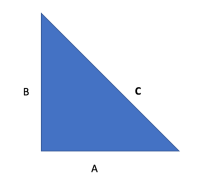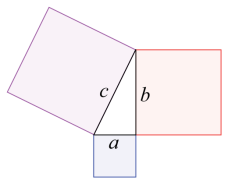In my job, I spend a lot of time explaining technology topics to my clients in simple english. Off late, a lot of such conversations are about AI, Data science, Quantum Computing etc . Those topics are rooted in maths and physics (amongst other things), and I often find there is some fear about math and science that exists in the minds of some people listening to me, and it gets in the way of their appreciation of technology.
I am also the dad of a teenage daughter who loves math and science. From my daughter and her friends and teachers – I got the feeling that many a time students get education in math and science in quite an abstract way, and it leads them to think “Why should I really learn any of this? I am not going to use this in real life”. In a few weeks, I am going to give a talk to high schoolers on how the math they learn in school manifests in real life in ways they may not have realized .
So I am going to try a couple of posts here to see if I can explain how simple math leads to powerful and beautiful things we see and use in our daily lives. I would really love your feedback on each topic including alternate/better explanations, and also your suggestions on what else would make good examples. If anyone wants to post a guest blog – we can consider that too.
Let me ease into it with simple math and see how it goes . We can build up from there . Here we go !
Pythagorean theorem
Lets start with the very simple and quite powerful Pythagorean theorem . It states that the square of the hypotenuse (the side opposite the right angle) is equal to the sum of the squares of the other two sides. We remember it via this elegant equation
A2 + B2 = C2 
This theorem has been proved in several ways , so we will skip that part and get to the fun aspects . If there are three positive numbers A, B and C where A2 + B2 = C2 is true, then it means that there exists a right angled triangle with A and B as the short sides and C as hypotenuse. Some of the fun is based on this converse property of this simple theorem.
How to make square edges on your garden bed
Any three numbers which make true is called a pythagorean triple. The numbers 3,4,5 form one such triple ( 3 squared is 9, 4 squared is 16. the sum of 9 and 16 is 25 which also happens to be the square of 5 ).
Here is a simple problem – lets say you are making a garden bed to plant vegetables. How do we make the edges square if all you have is a tape measure ? Easy – just make a a triangle with sides 3, 4 and 5 units using the tape and mark the end points on the ground. Voila – You have edges at perfect square !
How big of a ladder do you need ?
An extension of this is also true for finding the length of a ladder required to paint a wall – probably a question kids get in school exams. If the point where the ladder needs to touch the wall is 4 meters, and the bottom of the ladder is 3 meters away from the wall on the floor – the length of the ladder needed is 5 meters !
Or let’s say you want to convert stairs into a ramp on your back porch – the same concept applies .
Real engineers use this information frequently – the one I remember the most from my college days is in surveying land, finding length of trusses etc .
Planning your next painting project
Lets say we draw three similar figures using the sides of the right angled triangle forming one side of those figures. Similar figures just mean the lengths of sides have same ratios, the included angle between sides are the same. Easy way to think about it is zooming a picture on your phone . All parts increase or decrease in size – but their ratio to each other stays the same . It does not matter what the figure is – it could be a square, a pentagon or another triangle. The area of the largest figure (the one using hypotenuse as one of its sides) is ALWAYS the same as the sum of areas of the two smaller figures. How cool is that ! See this picture from wikipedia to see what I mean

Lets say these three squares are walls you need to paint . For the same quantity of paint you will need to paint the largest square – you can paint both the smaller squares !
How much marinara do you need ?
It’s not just about squares either – this area computation via Pythagorean triples also applies to circles . So for the the quantity of marinara you need for a 5 inch pizza can be used to coat both a 3 inch and 4 inch pizza ! If your mom is like mine – I wouldn’t advice trying this math on her while she is making you pizza . Theory of “mom is always right” over rules every other rule 🙂
If you are a social media marketer
You probably are a fan of Metcalfe’s law which says the value of a network is proportional to the square of the number of connected users in it . Let’s say you are given access to three potential networks . A has 3 connections , B has 4 connections and C has 5 connections . Since The squares of A and B add to the square of C – you get as much out of a network with 5 connections as you would get from A and B which together add to 7 connections . Spend your time and money wisely !
PS : I have my own misgivings on this – but would like to hear your feedback anyway . I didn’t come up with this myself and can’t remember anymore who told me this originally . But I have teased many a marketer friend with this at social events 🙂
What’s next
I think I would like to example the wonderful pi next . There is pi in pie !
Well done and interesting. Hadn’t thought about Pythagoras and pizza…
I just finished a 2 1/2 year assignment performing analytics for a Fin Svcs COO. She and her reports would talk about “advanced analytics” but their actual needs were highly concentrated on counts, averages, change rates and the like. The old standards are very powerful.
LikeLike
Thanks…and in general, most new methods have a firm foundation on the old ones
LikeLike
Hi Vijay, please share your ppt on applied math to high schoolers. Currently, I’m teaching Junior Achievement and I get ask how math will apply in their future. Thanks!
LikeLike
Hey Vijay, I love this post! Brings me back to my school days and how much I loved math 🙂 Quick feedback – I think you meant to say ‘3 meters away from the wall’ in the ‘How big of a ladder do you need ?’ paragraph 😉
LikeLike
I had fixed it…is it still showing up as 4 for you?
LikeLike
Looks good now
LikeLike
This is so aspirational. I recently had an adult niece in the store and she asked which cream cheese I wanted her to pick up, the $3 one or the one that was 2 for $5. I told her I’d prefer the cheaper one and she said “are you seriously expecting me to do math?”
LikeLiked by 1 person
I see this all the time with the kids at cash registers at the local stores. Without a calculator they can’t do basic arithmetic. Its an unfortunate part of our education system
LikeLike
Good morning Vijay – it’s been a while. Not long after I moved to Vermont from Boulder Colorado I met a MIT electrical engineer named John. We became friends and I even attended his wedding to his wife Diane. John may well be the smartest person I’ve ever met – although engaging in face to face conversation with John is sometimes disconcerting as I always got the impression that while he was talking to me he was also solving some other problem or coming up with some new idea. John was so good at chip design and design automation that even after just a couple of years at IBM he embarked on a temporary assignment in the UK at I believe it was called the Hursley Lab. I don’t think it was too long after he returned that he then spent 3 years at Carnegie Mellon (on IBM’s dime) to earn his Ph D. in electrical engineering.
John has earned many patents at IBM but he is also passionate about teaching science to children. He has done this at Disney World in Florida among other places. He is also an IBM Fellow. His name is John Cohn (you may already know him or of him) and he and his wife live in an old school house in Jonesville Vermont. I have not spoken or seen John in many years and it might be presumptuous in the extreme for me to suggest you contact John about his volunteer work as an educator but he might have some ideas and or presentations that you might find helpful. Cheers
P.S. Enjoy your blogs.
Charlie Quintana ctquintana@gmail.com 802.363.6927
>
LikeLiked by 1 person
Long time indeed my friend ! I will reach out to John and get introduced
LikeLike
Vijay, I like the way you explained it for social media marketer… Need to share this with my wife as she works in this field and would like to explore more.
LikeLiked by 1 person
I am very curious to hear her feedback
LikeLike